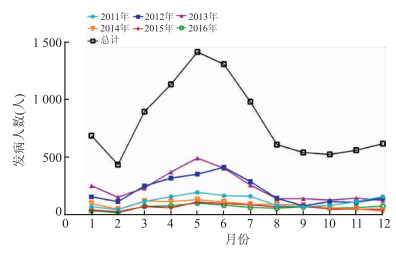-
摘要:
目的 分析2011-2016年合肥市流行性腮腺炎的流行病学特征,为更加有效地防控流行性腮腺炎提供依据。 方法 对合肥市2011-2016年流行性腮腺炎的发病数据进行描述性分析。 结果 2011-2016年合肥市流行性腮腺炎共发病9 678例,年均报告发病率为22.7/10万,其中2013年发病率最高,为40.56/10万。每年春季为发病高峰,5月发病数最多,冬季病例稍有增多但高峰不明显;流行性腮腺炎高发于3~13岁的儿童和青少年,男性患者多于女性患者(男女比为1.87:1);病例数最多的人群主要是学生,占总病例数的64.5%,其次是幼托儿童和散居儿童;合肥市9个县区的年均发病率也存在一定差异(χ2=256.845,P < 0.001)。 结论 合肥市2011-2016年流行性腮腺炎发病率较高,应在免疫接种方面采取更为有效的措施,以预防流行性腮腺炎的发病。 Abstract:Objective To analyze the epidemiological characteristics of mumps in Hefei City from 2011 to 2016, in order to provide a basis for effective prevention of mumps. Methods The data of mumps in Hefei City from 2011 to 2016 was analyzed by descriptive epidemiology. Results There were a total of 9 678 cases of mumps in Hefei City from 2011 to 2016. The average annual incidence was 22.7/100 000, with the highest in 2013 being 40.56/100 000. Mumps had obvious seasonality with high incidence in spring. Mumps cases increased in winter but the peak was not distinct. The group with the largest number of cases was mainly students, accounting for 64.5% of the total number of cases, followed by childcare and residentially-scattered children. The average annual morbidity of nine counties existed differences(χ2=256.845, P < 0.001). Conclusions There was a high incidence of mumps in Hefei City from 2011 to 2016. More effective measures should be taken to prevent the incidence of mumps and reduce the spread of mumps virus. -
Key words:
- Mumps /
- Epidemiological characteristics /
- Incidence
-
表 1 2011-2016年合肥市流腮发病地区分布
Table 1. Region distribution of mumps in Hefei City from 2011 to 2016
县(区) 年均发病数(人) 年均报告发病率(/10万) 蜀山区 302 38.61 庐阳区 70 14.97 包河区 192 35.84 瑶海区 179 29.34 肥东县 164 15.32 肥西县 253 29.79 庐江县 203 16.95 长丰县 103 13.47 巢湖市 147 16.86 -
[1] Latner DR, Hickman CJ. Remembering mumps[J]. Plos Pathog, 2015, 11(5): e1004791. DOI: 10.1371/journal.ppat.1004791. [2] Muhlemann K. The molecular epidemiology of mumps virus[J]. Infect Genet Evol, 2004, 4(3): 215-219. DOI: 10.1016/j.meegid.2004.02.003. [3] Hviid A, Rubin S, Mühlemann K. Mumps[J]. Lancet, 2008, 371(9616): 932-944. doi: 10.1016/S0140-6736(08)60419-5 [4] 王琴, 陈俊磊, 林岩, 等. 2005-2015年福建省流行性腮腺炎流行病学特征分析[J]. 现代预防医学, 2017, 44(17): 3093-3108. https://www.cnki.com.cn/Article/CJFDTOTAL-XDYF201717009.htmWang Q, Chen JL, Lin Y, et al. Epidemiological characteristics of mumps in Fujian, 2005-2015[J]. Modern Prev Med, 2017, 44(17): 3093-3108. https://www.cnki.com.cn/Article/CJFDTOTAL-XDYF201717009.htm [5] 蒋蕊鞠, 殷琼洲, 徐明钰, 等. 2004~2018年全国流行性腮腺炎发病特征及重点防控人群分析[J]. 中国当代儿科杂志, 2019, 21(5): 441-444. DOI: 10.7499/j.issn.1008-8830.2019.05.008.Jiang RJ, Yin QZ, Xu MY, et al. Epidemiological characteristics of mumps in mainland China from 2004 to 2018 and key population for prevention and control[J]. Chin J Contemp Pediatr, 2019, 21(5): 441-444. DOI: 10.7499/j.issn.1008-8830.2019.05.008. [6] 胡咏梅, 郝利新, 王华庆. 中国2010-2012年流行性腮腺炎流行病学特征分析[J]. 中国疫苗和免疫, 2014, 20(2): 127-131. https://www.cnki.com.cn/Article/CJFDTOTAL-ZGJM201402008.htmHu YM, Hao LX, Wang HQ. Analysis on Epidemiological Characteristic of Mumps in China, 2010-2012[J]. Chinese Journal of Vaccines and Immunization, 2014, 20(2): 127-131. https://www.cnki.com.cn/Article/CJFDTOTAL-ZGJM201402008.htm [7] Lu QB, Ding ZY, Wu C, et al. Analysis of epidemiological characteristics of notifiable diseases reported in children aged 0-14 years from 2008 to 2017 in Zhejiang Province, China[J]. Int J Environ Res Public Health, 2019, 16(2): 168. DOI: 10.3390/ijerph16020168. [8] 杨小兵, 汪鹏, 孔德广, 等. 武汉市2005-2011年流行性腮腺炎流行病学特征分析[J]. 公共卫生与预防医学, 2013, 24(2): 43-46. https://www.cnki.com.cn/Article/CJFDTOTAL-FBYF201302015.htmYang XB, Wang P, Kong DG, et al. Epidemiological characteristics of mumps in Wuhan City (2005-2011)[J]. J of Pub Health and Prev Med, 2013, 24(2): 43-46. https://www.cnki.com.cn/Article/CJFDTOTAL-FBYF201302015.htm [9] 邱琳, 郭晓荣, 郁会莲, 等. 2007-2011年陕西省流行性腮腺炎流行病学分析[J]. 中华疾病控制杂志, 2013, 17(4): 325-327. http://zhjbkz.ahmu.edu.cn/article/id/JBKZ201304016Qiu L, Guo XR, Yu HL, et al. Epidemiological analysis on mumps in Shaanxi Province from 2007 to 2011[J]. Chin J Dis Control Prev, 2013, 17(4): 325-327. http://zhjbkz.ahmu.edu.cn/article/id/JBKZ201304016 [10] 戴孟阳, 孙岩. 沈阳市2005-2014年流行性腮腺炎流行特征分析[J]. 中国初级卫生保健, 2016, 30(1): 47-49. DOI: 10.3969/j.issn.1001-568X.2016.01.0018.Dai MY, Sun Y. Analysis on Mump's epidemic characteristics in Shenyang from 2005 to 2014[J]. Chinese Primary Health Care, 2016, 30(1): 47-49. DOI: 10.3969/j.issn.1001-568X.2016.01.0018. [11] 李婷婷, 田余红, 齐筱倩, 等. 2005-2012年合肥市蜀山区流行性腮腺炎的流行病学特征分析[J]. 安徽医学, 2013, 34(12): 1843-1846. DOI: 10.3969/j.issn.1000-0399.2013.12.042.Li TT, Tian YH, Qi XQ, et al. Analysis on epidemiological characteristics of mumps in Shushan district of Hefei from 2005 to 2012[J]. Anhui Medical Journal, 2012, 34(12): 1843-1846. DOI: 10.3969/j.issn.1000-0399.2013.12.042. [12] 苏琪茹, 刘隽, 马超, 等. 2004-2013年中国流行性腮腺炎流行病学特征分析[J]. 中华预防医学杂志, 2016, 50(7): 611-614. DOI: 10.3760/cma.j.issn.0253-9624.2016.07.009.Su QR, Liu J, Ma C, et al. Epidemic profile of mumps in China during 2004-2013[J]. Chin J Prev Med, 2016, 50(7): 611-614. DOI: 10.3760/cma.j.issn.0253-9624.2016.07.009. [13] 钟贵良, 林希建, 刘姝. 2008-2012年长沙市流行性腮腺炎流行病学特征分析[J]. 中华疾病控制杂志, 2014, 18(2): 120-122. http://zhjbkz.ahmu.edu.cn/article/id/JBKZ201402009Zhong GL, Lin XJ, Liu S. Analysis on epidemiological characteristics of mumps in Changsha City from 2008 to 2012[J]. Chin J Dis Control Prev, 2014, 18(2): 120-122. http://zhjbkz.ahmu.edu.cn/article/id/JBKZ201402009 [14] Zamir CS, Schroeder H, Shoob H, et al. Characteristics of a large mumps outbreak: clinical severity, complications and association with vaccination status of mumps outbreak cases[J]. Hum Vaccin Immunother, 2015, 11(6): 1413-1417. DOI: 10.1080/21645515.2015.1021522. [15] 周其宏, 冯晓明, 汪银, 等. 皖南山区流行性腮腺炎发病趋势的智能预测模型[J]. 中华疾病控制杂志, 2010, 14(8): 739-741. http://zhjbkz.ahmu.edu.cn/article/id/JBKZ201008018Zhou QH, Feng XM, Wang Y, et al. A forecast model study on the ineidence of mumps in southern Anhui Province[J]. Chin J Dis Control Prev, 2010, 14(8): 739-741. http://zhjbkz.ahmu.edu.cn/article/id/JBKZ201008018 -





 下载:
下载:


